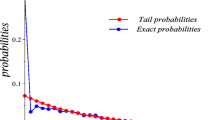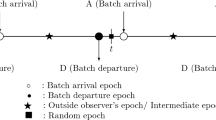Abstract
The present study investigates a single-server batch service queueing model with arrival process as discrete-time Markovian arrival process and service process as discrete-time Markovian service process. The server serves the customers in batches followed by the general bulk-service rule. We first determine the random epoch probabilities using the matrix-geometric method, where the rate matrix \({\mathbf{R}}\) is determined by an efficient approach based on the eigenvalues and the corresponding eigenvectors of the associated characteristic equation. Next we obtain the explicit closed-form expressions for the pre-arrival, intermediate, outside observer’s and post-departure epoch probabilities by developing the relations among them in equilibrium state. Further, we provide an analytically simple approach to carry out the waiting-time distribution in the queue measured in slots as well as the distribution of the size of a service batch of an arriving customer. We also demonstrate a cost function to evaluate the optimum value of the minimum service batch size and the corresponding expected cost of the system. Finally, an adequate variety of numerical experiments are performed for validation purpose of our analytical results and they are conferred in the form of tables and graphs.




Similar content being viewed by others
References
Abolnikov L, Dukhovny A (2003) Optimization in HIV screening problems. J Appl Math Stoch Anal 16:361–374
Alfa AS (2016) Applied discrete-time queues, 2nd edn. Springer, New York
Alfa AS, Chakravarthy S (1994) A discrete queue with the Markovian arrival process and phase type primary and secondary services. Stoch Models 10:437–451
Alfa AS, Liu B, He QM (2003) Discrete-time analysis of \(MAP/PH/1\) multiclass general preemptive priority queue. Naval Res Logist 50(6):662–682
Alfa AS, Xue J, Ye Q (2000) Perturbation theory for the asymptotic decay rates in the queues with Markovian arrival process and/or Markovian service process. Queueing Syst 36:287–301
Avram F, Gòmez-Corral A (2006) On bulk-service \(MAP/PH^{(L, N)}/1/N\) G-queues with repeated attempts. Ann Oper Res 141:109–137
Banerjee A, Gupta UC, Chakravarthy SR (2015) Analysis of a finite-buffer bulk-service queue under Markovian arrival process with batch-size-dependent service. Comput Oper Res 60:138–149
Banik AD (2015) Single server queues with a batch Markovian arrival process and bulk renewal or non-renewal Service. J Syst Sci Syst Eng 24(3):337–363
Bank B, Samanta SK (2020) Analytical and computational studies of the \(BMAP/G^{(a,Y)}/1\) queue. Commun Stat Theory Methods. https://doi.org/10.1080/03610926.2019.1708941
Bar-Lev SK, Blanc H, Boxma O, Janssen G, Perry D (2013) Tandem queues with impatient customers for blood screening procedures. Methodol Comput Appl Probab 15(2):423–451
Bhaskar V, Lallement P (2010) Modeling a supply chain using a network of queues. Appl Math Model 34:2074–2088
Chaudhry ML, Banik AD, Pacheco A, Ghosh S (2016) A simple analysis of system characteristics in the batch service queue with infinite-buffer and Markovian service process using the roots method: \(GI/C\)-\(MSP^{(a, b)}/1/\infty\). RAIRO Oper Res 50:519–551
Chaudhry ML, Templeton JGC (1983) A first course in bulk queues. Wiley, New York
D’Arienzo MP, Dudin AN, Dudin SA, Manzo R (2020) Analysis of a retrial queue with group service of impatient customers. J Ambient Intell Humaniz Comput 11(6):2591–2599
Gail HR, Hantler SL, Taylor BA (1996) Spectral analysis of \(M/G/1\) and \(G/M/1\) type Markov chains. Adv Appl Probab 28(1):114–165
Grassmann WK, Drekic S (2008) Multiple eigenvalues in spectral analysis for solving QBD processes. Methodol Comput Appl Probab 10(1):73–83
Gupta UC, Laxmi PV (2001) Analysis of the \(MAP/G(a, b)/1/N\) queue. Queueing Syst 38:109–124
Gupta UC, Samanata SK, Sharma RK, Chaudhry ML (2007) Discrete-time single-server finite-buffer queues under discrete Markovian arrival process with vacations. Perform Eval 64:1–19
Gyasi-Agyei Y (2001) Modelling diurnal cycles in point rainfall properties. Hydrol Process 15(4):595–608
Horváth A, Horváth G, Telek M (2010) A joint moments based analysis of networks of \(MAP/MAP/1\) queues. Perform Eval 67:759–778
Horváth G, Van Houdt B, Telek M (2014) Commuting matrices in the queue length and sojourn time analysis of \(MAP/MAP/1\) queues. In: The eighth International Conference on Matrix-Analytic Methods in Stochastic Models (MAM8), Calicut, India. https://pdfs.semanticscholar.org/8c8d/14e9ac701fbc3f0a87b72be22ddc5ba4856a.pdf
Kawase Y, Kasahara S (2018) A batch-service queueing system with general input and its application to analysis of mining process for bitcoin blockchain. In: 2018 IEEE Confs on Internet of Things, Green Computing and Communications, Cyber, Physical and Social Computing, Smart Data, Blockchain, Computer and Information Technology, Congress on Cybermatic, pp 1440–1447
Koo PH, Moon DH (2013) A review on control strategies of batch processing machines in semiconductor manufacturing. In: 7th IFAC Conference on manufacturing modelling, management, and control international federation of automatic control, Saint Petersburg, Russia, IFAC Proceedings, vol 46, no 9, pp 1690–1695
McDonnell J, Goverde AJ, Rutten FFH, Vermeiden JPW (2002) Multivariate Markov chain analysis of the probability of pregnancy in infertile couples undergoing assisted reproduction. Hum Reprod 17(1):103–106
Medhi J (1975) Waiting time distribution in a Poisson queue with a general bulk service rule. Manage Sci 21(7):777–782
Medhi J (1991) Stochastic models in queueing theory. Academic Press, Boston
Mitrani I, Chakka R (1995) Spectral expansion solution for a class of Markov models: application and comparison with the matrix-geometric method. Perform Eval 23:241–260
Mullubhatla R, Pattipati KR (2000) Discrete-time Markov reward models of automated manufacturing systems with multiple part types and random rewards. IEEE Trans Robot Autom 16(5):553–566
Neuts MF (1967) A general class of bulk queues with Poisson input. Ann Math Stat 38(3):759–770
Neuts MF (1981) Matrix-geometric solutions in stochastic models. Johns Hopkins University Press, Baltimore
Neuts MF (1989) Structured stochastic matrices of \(M/G/1\) type and their applications. CRC Press, Marcel Dekker, New York
Nishimura S, Tominaga H, Shigeta T (2006) A computational method for the boundary vector of a \(BMAP/G/1\) queue. J Oper Res Soc Jpn 49(2):83–97
Norberg T, Rosén L, Baran A, Baran S (2002) On modeling discrete geological structures as Markov random fields. Math Geol 34(1):63–77
Ozawa T (2004) Analysis of queues with Markovian service processes. Stoch Models 20(4):391–413
Pradhan S, Gupta UC (2019) Analysis of an infinite-buffer batch-size-dependent service queue with Markovian arrival process. Ann Oper Res 277:161–196
Samanta SK, Bank B (2020) Extended analysis and computationally efficient results for the \(GI/M^{a,b}/1\) queueing system. Commun Stat Theory Methods. https://doi.org/10.1080/03610926.2020.1801739
Samanta SK, Chaudhry ML, Pacheco A (2016) Analysis of \(BMAP/MSP/1\) queue. Methodol Comput Appl Probab 18:419–440
Samanta SK, Zhang ZG (2012) Stationary analysis of a discrete-time \(GI/D\)-\(MSP/1\) queue with multiple vacations. Appl Math Model 36:5964–5975
Santhi K, Saravanan R (2017) Performance analysis of cloud computing bulk service using queueing models. Int J Appl Eng Res 12(17):6487–6492
Schwarz JA, Epp M (2016) Performance evaluation of a transportation-type bulk queue with generally distributed inter-arrival times. Int J Prod Res 54(20):6251–6264
Sim SH, Templeton JGC (1985) Steady state results for the \(M/M^{(a, b)}/c\) batch-service system. Eur J Oper Res 21:260–267
Singh G, Gupta UC, Chaudhry ML (2013) Computational analysis of bulk service queue with Markovian arrival process: \(MAP/R^{(a, b)}/1\) queue. Opsearch 50:582–603
Wang YC, Chou JH, Wang SY (2011) Loss pattern of \(DBMAP/DMSP/1/K\) queue and its application in wireless local communications. Appl Math Model 35:1782–1797
Acknowledgements
We thank anonymous referees for careful reading of the paper leading to a number of improvements.
Author information
Authors and Affiliations
Corresponding author
Additional information
Publisher's Note
Springer Nature remains neutral with regard to jurisdictional claims in published maps and institutional affiliations.
Appendix: Commuting matrices
Appendix: Commuting matrices
Horváth et al. (2014) proved that \({\mathbf{R}}\) and \(({\mathbf{I}}_{m_1}\otimes {\mathbf{L}}_0)+{\mathbf{R}}({\mathbf{I}}_{m_1}\otimes {\mathbf{L}}_1)\) commute for continuous-time MAP/MSP/1 queueing model. Now, we extend the proof of the commutativity for our proposed bulk-service discrete-time queueing model, i.e., \({\mathbf{R}}\) and \(({\mathbf{I}}_{m_1}\otimes \mathbf{L}_0)+{\mathbf{R}}^b({\mathbf{I}}_{m_1}\otimes {\mathbf{L}}_1)\) commute. According to the spectral decomposition approach conferred in Horváth et al. (2014), we establish the commutativity for our queueing model.
Assumption 1
We assume that the matrices \({\mathbf{D}}_1+\alpha _i{\mathbf{D}}_0\) and \(\mathbf{L}_0+\alpha _i^b{\mathbf{L}}_1\) can be diagonalized for \(i=1,2,\ldots , m\).
Lemma 1
If \(\mathbf{U}\) and \(\mathbf{V}\) be two square matrices of order \(m_1\) and \(m_2\), respectively, such that they are diagonalizable then \(\mathbf{U}\otimes \mathbf{V}\) is also diagonalizable. Moreover, if \(\mathbf{u}_i\) is the left eigenvector of \(\mathbf{U}\) corresponding to the eigenvalue \(\theta _i\) for \(i=1,2,\ldots ,m_1\) and \(\mathbf{v}_j\) is the left eigenvector of \(\mathbf{V}\) corresponding to the eigenvalue \(\delta _j\) for \(j=1,2,\ldots ,m_2\), then \(\mathbf{U}\otimes \mathbf{V}\) has left eigenvector \(\mathbf{u}_i\otimes \mathbf{v}_j\) corresponding to the eigenvalue \(\theta _i\delta _j\).
Lemma 2
If \({{\varvec{\eta }}}_i\) be the left eigenvector of the matrix \({\mathbf{R}}\) corresponding to the eigenvalue \(\alpha _i\) for \(i=1,2,\ldots , m\), then \({{\varvec{\eta }}}_i\) is also left eigenvector of \(({\mathbf{I}}_{m_1}\otimes ({\mathbf{L}}_0+\alpha _i^b\mathbf{L}_1))\).
Proof
Pre-multiplying (6) by \({\varvec{\eta }}_i\) and using \({{\varvec{\eta }}}_i\mathbf{R}=\alpha _i{{\varvec{\eta }}}_i\), for \(i=1,2,\ldots , m\), we have
This implies that \({\varvec{\eta }}_i\) is the left eigenvector of \(\left[ (\mathbf{D}_1+\alpha _i{\mathbf{D}}_0) \otimes ({\mathbf{L}}_0+\alpha _i^b\mathbf{L}_1)\right]\) corresponding to the eigenvalue \(\alpha _i\). According to our above Assumption 1 and Lemma 1, if \({{\varvec{\upsilon }}}_{i,j}\) is the left eigenvector of \(({\mathbf{D}}_1+\alpha _i\mathbf{D}_0)\) corresponding to the eigenvalue \(\xi _{i,j}\), for \(j=1,2,\ldots , m_1\), and \({{\varvec{\phi }}}_{i,k}\) is the left eigenvector of \(({\mathbf{L}}_0+\alpha _i^b{\mathbf{L}}_1)\) corresponding to the eigenvalue \(\gamma _{i,k}\), for \(k=1,2,\ldots , m_2\) then we have \({\varvec{\eta }}_i={\varvec{\upsilon }}_{i,p_i}\otimes {\varvec{\phi }}_{i,r_i}\) and \(\alpha _i=\xi _{i,p_i}\gamma _{i,r_i}\), for some \(p_i\in \{1,2,\ldots , m_1\}\) and \(r_i\in \{1,2,\ldots ,m_2\}\). Therefore, we have
Hence, it is proved that \({{\varvec{\eta }}}_i\) is the left eigenvector of \(({\mathbf{I}}_{m_1}\otimes ({\mathbf{L}}_0+\alpha _i^b{\mathbf{L}}_1))\). \(\square\)
Lemma 3
If \({{\varvec{\eta }}}_i\) be the left eigenvector of the matrix \({\mathbf{R}}\) corresponding to the eigenvalue \(\alpha _i\) for \(i=1,2,\ldots , m\), then \({{\varvec{\eta }}}_i\) is also the left eigenvector of \(({\mathbf{I}}_{m_1}\otimes {\mathbf{L}}_0)+{\mathbf{R}}^b(\mathbf{I}_{m_1}\otimes {\mathbf{L}}_1)\) corresponding to the eigenvalue \(\gamma _{i,r_i}.\)
Proof
Using Lemma 2, we can write
\(\square\)
Theorem
Under Assumption 1, the matrices \({\mathbf{R}}\) and \(({\mathbf{I}}_{m_1}\otimes {\mathbf{L}}_0)+{\mathbf{R}}^b(\mathbf{I}_{m_1}\otimes {\mathbf{L}}_1)\) commute.
Proof
From Lemma 3, we can say that \({\mathbf{R}}\) and \(({\mathbf{I}}_{m_1}\otimes {\mathbf{L}}_0)+{\mathbf{R}}^b({\mathbf{I}}_{m_1}\otimes {\mathbf{L}}_1)\) are simultaneously diagonalizable. Therefore, there exists a matrix \({\mathbf{Y}}\) such that
where
Now, using (18), we have
Hence, it is proved that \({\mathbf{R}}\) and \(({\mathbf{I}}_{m_1}\otimes \mathbf{L}_0)+ {\mathbf{R}}^b({\mathbf{I}}_{m_1}\otimes {\mathbf{L}}_1)\) commute each other. \(\square\)
Rights and permissions
About this article
Cite this article
Samanta, S.K., Das, K. Computing stationary distributions of the D-MAP/D-MSP\(^{(a,b) }/1\) queueing system. J Ambient Intell Human Comput 13, 571–590 (2022). https://doi.org/10.1007/s12652-021-02919-1
Received:
Accepted:
Published:
Issue Date:
DOI: https://doi.org/10.1007/s12652-021-02919-1




